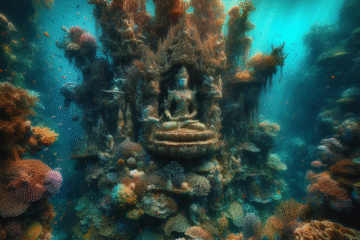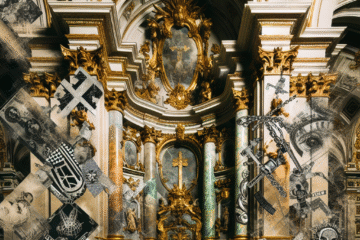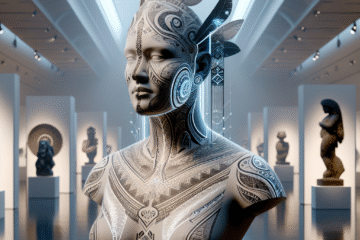I. Introduction
Contemporary art has always been a reflection of the times in which it is created. As we enter the digital age, it is only natural that artists are exploring new tools and platforms to create and share their work. Digital technology has not only changed the way we experience art but has also opened up new possibilities for artists to create and distribute their work.
In this article, we will explore the topic of contemporary art in the digital age. We will discuss the rise of digital art and its evolution from early experiments with computer-generated imagery to the rise of NFTs. We will also explore different forms of digital art, such as video art, net art, virtual and augmented reality, and interactive installations. Additionally, we will analyze how digital technology has influenced contemporary art in terms of form, content, and distribution.
It is important to understand how artists are using digital tools and platforms to create and share their work because it is changing the way we think about art. Digital technology is providing new avenues for artists to express themselves and connect with audiences. Moreover, it is challenging traditional notions of art-making, and expanding the possibilities of what art can be.
Through this article, we hope to provide a comprehensive overview of the intersection between contemporary art and digital technology. We will also examine the critiques and challenges of digital art, including concerns about authenticity, ownership, and sustainability. By exploring these topics, we aim to deepen our understanding of the role that digital technology is playing in the evolution of contemporary art, and how it is shaping the art world for years to come.
II. The Rise of Digital Art
The history of digital art can be traced back to the 1960s when artists first began experimenting with computer-generated imagery. However, it wasn’t until the 1980s and 1990s that digital art gained widespread recognition as a legitimate form of artistic expression. During this time, artists began using digital tools and platforms to create works that blurred the line between art and technology.
One of the pioneers of digital art was Nam June Paik, a Korean-American artist who is often credited with inventing video art. Paik’s work challenged the traditional boundaries of art by using television sets as sculptural elements and incorporating video and sound into his installations. His work paved the way for other artists to explore new forms of artistic expression using technology.
Another artist who has pushed the boundaries of digital art is Cory Arcangel. Arcangel is known for his use of computer programming and software to create works that comment on contemporary culture. His work often involves hacking and manipulating existing digital content, such as video games or music, to create something entirely new.
More recently, the Japanese art collective teamLab has gained international recognition for their immersive digital installations. Their works often involve projected images and interactive elements, creating a multisensory experience for viewers. Their pieces challenge traditional notions of art exhibitions and often involve large-scale installations that blur the line between the physical and digital worlds.
Digital tools and platforms have also expanded the possibilities for creating, exhibiting, and collecting art. Artists can now use digital tools to create works that were once impossible, such as 3D printing, virtual reality, and augmented reality. Digital platforms such as social media and online marketplaces have made it easier for artists to share their work with a global audience and connect with collectors.
One of the most recent developments in the digital art world is the rise of NFTs (non-fungible tokens). NFTs are digital assets that use blockchain technology to verify ownership and authenticity. They have opened up new opportunities for artists to monetize their digital works and for collectors to invest in digital art.
In conclusion, the rise of digital art has transformed the way we think about artistic expression. From early experiments with computer-generated imagery to the rise of NFTs, digital technology has enabled artists to explore new forms of artistic expression and connect with a global audience. As technology continues to evolve, we can expect to see even more exciting developments in the world of digital art.
III. Exploring Different Forms of Digital Art
Digital art is a broad term that encompasses a range of different forms and techniques. In this section, we will explore some of the major categories of digital art, including video art, net art, virtual and augmented reality, and interactive installations. We will showcase examples of each type of digital art and discuss their unique qualities and challenges.
- Video Art Video art is a form of digital art that uses video and sound to create a multisensory experience for viewers. It can range from experimental and abstract to more narrative-based works. One example of video art is Bill Viola’s “The Crossing,” which features slow-motion footage of two individuals passing each other in a pool of water. The work explores themes of life and death, and the cyclical nature of human existence.
- Net Art Net art is a form of digital art that is created and distributed through the internet. It often involves using web-based technologies such as HTML, CSS, and JavaScript. One example of net art is Olia Lialina’s “My Boyfriend Came Back From the War,” which was created in 1996. The work is an interactive story that allows users to click through different frames and explore different paths of the narrative.
- Virtual and Augmented Reality Virtual and augmented reality are forms of digital art that use computer-generated environments to create immersive experiences for viewers. Virtual reality (VR) creates a completely artificial environment that can be explored using a headset. Augmented reality (AR), on the other hand, overlays digital content onto the real world, often using a smartphone or tablet. One example of virtual reality art is Marina Abramović’s “Rising,” which immerses viewers in a world that is gradually being flooded due to climate change.
- Interactive Installations Interactive installations are a form of digital art that invites viewers to become active participants in the work. They often involve using sensors, cameras, and other technologies to respond to the viewer’s movements or actions. One example of an interactive installation is Rafael Lozano-Hemmer’s “Pulse Room,” which features hundreds of light bulbs that flicker in response to the viewer’s heartbeat.
Each form of digital art presents unique qualities and challenges. Video art and net art, for example, can be easily shared online, but may not translate as well to physical exhibitions. Virtual and augmented reality art requires specialized equipment and may be inaccessible to some viewers. Interactive installations can be engaging and participatory, but also require careful installation and maintenance.
In conclusion, digital art is a constantly evolving field that offers endless possibilities for artistic expression. By exploring different forms of digital art, we can gain a deeper appreciation for the unique qualities and challenges of each. As technology continues to advance, we can expect to see even more exciting and innovative forms of digital art in the future.
IV. The Impact of Digital Technology on Contemporary Art
Digital technology has had a profound impact on contemporary art in terms of form, content, and distribution. In this section, we will analyze how digital technology has influenced contemporary art and how it has enabled artists to create work that engages with current issues such as social justice, climate change, and identity. We will also discuss the democratizing effect of digital platforms on the art world, including the rise of online marketplaces and social media.
- Form Digital technology has expanded the possibilities of what art can be. Artists can now use digital tools to create works that were once impossible, such as 3D printing, virtual reality, and augmented reality. These new forms of artistic expression have allowed artists to push the boundaries of what is possible in contemporary art.
One example of this is the work of artist Tamiko Thiel. Thiel creates augmented reality installations that explore issues such as climate change and social justice. Her work “Unexpected Growth” features virtual flowers that grow and bloom in response to the viewer’s presence. By using augmented reality, Thiel is able to create an immersive and interactive experience for viewers that would not be possible with traditional media.
- Content Digital technology has also enabled artists to create work that engages with current issues such as social justice, climate change, and identity. Through the use of digital tools and platforms, artists can reach a global audience and spark conversations about important issues.
One example of this is the work of artist LaTurbo Avedon. Avedon creates digital avatars that explore themes of identity and representation in the digital age. Her work challenges traditional notions of identity and gender by creating virtual personas that exist outside of physical bodies.
- Distribution Digital platforms have also democratized the art world by making it easier for artists to share their work with a global audience. Online marketplaces such as Artsy and Saatchi Art have made it easier for collectors to discover and purchase art from a range of artists around the world. Social media platforms such as Instagram have also become important tools for artists to promote their work and connect with audiences.
One example of this is the work of artist Amalia Ulman. Ulman gained international recognition for her Instagram performance art piece “Excellences & Perfections,” in which she created a fictional persona and documented her life on Instagram. The piece challenged the authenticity of social media and highlighted the power of digital platforms in shaping our perceptions of reality.
In conclusion, digital technology has had a transformative impact on contemporary art. Through the use of digital tools and platforms, artists can create new forms of artistic expression, engage with important issues, and reach a global audience. The democratising effect of digital platforms has also opened up new opportunities for artists to share their work with collectors and audiences around the world. As technology continues to advance, we can expect to see even more exciting developments in the world of digital art.
V. Critiques and Challenges of Digital Art
While digital technology has opened up new possibilities for artistic expression, it has also presented a number of critiques and challenges for digital art. In this section, we will acknowledge some of these critiques and challenges, such as concerns about authenticity, ownership, and sustainability. We will also discuss how digital art is changing the way we think about the role of the artist, the value of art, and the relationship between art and technology.
- Authenticity One critique of digital art is the challenge of maintaining authenticity. Digital art is easily replicable, and it can be difficult to determine the original or authentic version of a work. Additionally, digital tools and platforms have made it easier for artists to manipulate or alter their work, raising questions about the integrity of the piece.
- Ownership Another challenge of digital art is ownership. Digital art is often intangible and can be easily copied or shared without permission, raising questions about copyright and ownership. Additionally, the rise of NFTs has created new questions about ownership and value in the digital art world.
- Sustainability A third challenge of digital art is sustainability. Digital art often relies on technology that can quickly become outdated or obsolete, making it difficult to maintain or preserve. Additionally, the energy required to power digital technology raises questions about the environmental impact of digital art.
Despite these challenges, digital art is changing the way we think about the role of the artist, the value of art, and the relationship between art and technology. Digital art challenges traditional notions of what art can be and who can create it. It also blurs the lines between different artistic mediums, creating new possibilities for interdisciplinary collaboration.
The democratizing effect of digital platforms has also created new opportunities for emerging artists to showcase their work and connect with a global audience. Digital art has challenged traditional gatekeepers of the art world and created new opportunities for diverse voices to be heard.
In conclusion, digital art presents both challenges and opportunities for artists and the art world. While concerns about authenticity, ownership, and sustainability remain, digital technology has expanded the possibilities of artistic expression and opened up new avenues for creativity and innovation. As technology continues to advance, we can expect to see even more exciting developments in the world of digital art, and new opportunities for artists to push the boundaries of what is possible in contemporary art.
VI. Conclusion
Throughout this article, we have explored the intersection between contemporary art and digital technology. We discussed the rise of digital art and its evolution from early experiments with computer-generated imagery to the rise of NFTs. We also explored different forms of digital art, such as video art, net art, virtual and augmented reality, and interactive installations. Additionally, we analyzed how digital technology has influenced contemporary art in terms of form, content, and distribution, while acknowledging the critiques and challenges of digital art.
It is important to consider digital art as a vital and dynamic part of contemporary art. Digital technology has opened up new avenues for artistic expression and created new opportunities for diverse voices to be heard. It has challenged traditional notions of what art can be and who can create it. Digital art has expanded the possibilities of what is possible in contemporary art and opened up new avenues for creativity and innovation.
Looking to the future, we can expect to see even more exciting developments in the world of digital art. As technology continues to advance, we can expect to see new forms of artistic expression and new opportunities for artists to push the boundaries of what is possible. We may also see new challenges and critiques emerge as digital art becomes increasingly prevalent in the art world. However, by considering these challenges and continuing to push the boundaries of what is possible in digital art, we can ensure that it remains a vital and dynamic part of contemporary art for years to come.
In conclusion, digital art is a constantly evolving field that offers endless possibilities for artistic expression. Through the use of digital tools and platforms, artists can create new forms of artistic expression, engage with important issues, and reach a global audience. While there are challenges and critiques to consider, it is important to recognise the value and potential impact of digital art on the art world. As we continue to explore the intersection between contemporary art and digital technology, we can expect to see even more exciting and innovative forms of digital art emerge.


